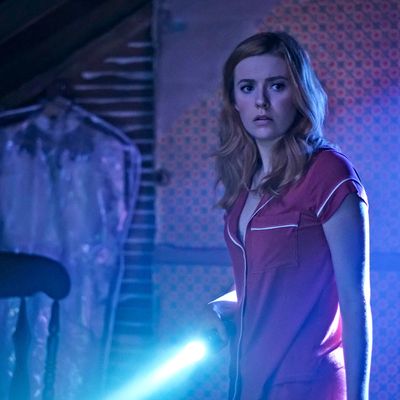
In the second episode of the CW’s new Nancy Drew, adapted from a decades-running series of novels about the intrepid “girl detective,” our heroine breaks into the morgue in her scandal-and-murder-wracked small town to take an unauthorized blood sample from the corpse of a woman murdered in the parking lot of a restaurant where Nancy works as a waitress. The problem is that there are several bodies on slabs, all hidden beneath sheets, and Nancy has to draw back each one to find the corpse with the blood she needs to sample. Each reveal gets a slow buildup, with silence doing a lot of the work of generating suspense, and of course each unblinking face Nancy exposes is more unsettling than the one before. When she uncovers the body she came for, its slick, unblinking eyes seem to stare right into her soul. And then, from elsewhere in the room, we hear a noise that may or may not be breathing.
The scene seemingly owes less to the original Nancy Drew novels than it does to David Lynch’s Twin Peaks and other TV series that have drawn from it — including the current CW hit Riverdale — as well as to the 1990s Scream-inspired tradition of self-reflexive comedy-horror built around teens and 20-somethings. And of course this Nancy Drew series probably wouldn’t exist without Veronica Mars, a cult classic that likely inspired many young women to get into crime fiction as readers or writers. But when you get right down to it, none of the works that the current Nancy Drew seems to be ripping off would have existed without the original Nancy Drew novels. Whether you’re watching Donna, Audrey, and Maddie sneak around Twin Peaks investigating the hidden life and tangled personality of their friend Laura Palmer; Sidney, Gale, and Tatum trying to escape the blade of a murderer whose tactics and clues are drawn from horror movies; or Veronica Mars picking locks and conducting surveillance, you’re seeing Nancy’s moves repurposed.
The Nancy Drew books were created by publisher Edward L. Stratemeyer and written by a variety of authors under the pseudonym Carolyn Keene, and they evolved (slowly) to keep pace with the increasing worldliness of their young, primarily female readership. But it’s still hard to imagine a Nancy Drew novel starting, as the pilot does, with a sex scene between Nancy (Kennedy McMann) and her boyfriend, Ned “Nick” Nickerson (Tunji Kasim); or one that haunts its heroine with horrifying, PTSD-like flashes of a murder victim who had just been named Sea Queen in a ceremony staged every year in the oceanside town of Horseshoe Bay, then died the same night by falling from a cliff and smashing her brains on the rocks.
I should preface this next observation by admitting that my Nancy Drew knowledge is limited to the books I read in the 1970s because I had a crush on Pamela Sue Martin, costar of the 1979 series The Hardy Boys/Nancy Drew Mysteries (who guest-stars on the CW series as a medium), and a few more in the early 2000s, when my daughter and her friends were briefly into a rebooted series titled Girl Detective, featuring a Nancy Drew who owns a cell phone and drives a hybrid. But I’m pretty sure the novels don’t intimate the existence of a supernatural world beyond what we can perceive with our senses, as this show seems to be doing with its flash cuts of hideous apparitions of the Sea Queen reflected in windows. Nor do they create an elaborate, gothic-tinged mythology for Nancy’s town, including a ceremony in which citizens leave buckets of seawater on their doorsteps at sundown and then check after midnight to see if it has turned to blood — signifying, in a twisted allusion to the Passover story, that the bucket’s owner is doomed. (Spoiler that’s probably not anything you couldn’t have anticipated if you watch TV: One of the characters finds blood in their bucket. The blood is a thick, vivid crimson, like in a 1970s Italian horror film.)
But all this falls under the heading of “stuff Nancy Drew probably absorbed from Twin Peaks, which was influenced by Nancy Drew and the Hardy Boys.” Lest you think I’m stretching in suggesting Lynch was familiar with both series of novels, which were inextricably linked over the decades: He grew up in the 1950s, probably the peak of Nancy Drew and the Hardy Boys’ influence, and during the original publicity for Blue Velvet — whose star, Kyle MacLachlan, would go on to star in Twin Peaks — Lynch jokingly described it as “the Hardy Boys go to Hell.” Whether Lynch actually read Nancy Drew in addition to the Hardy Boys, he almost certainly knew girls who did.
All of which makes the new Nancy Drew a full-circle reminder that sometimes works that appear to borrow from what came before are actually reclaiming inspirations that these gifted to pop culture long ago. When you look at how the source material influenced subsequent TV series and movies and then look at what the adaptations take from works inspired by Nancy Drew, you get a sense of the ecosystem of influence that continues across the decades, inspiring successive generations of creators.


